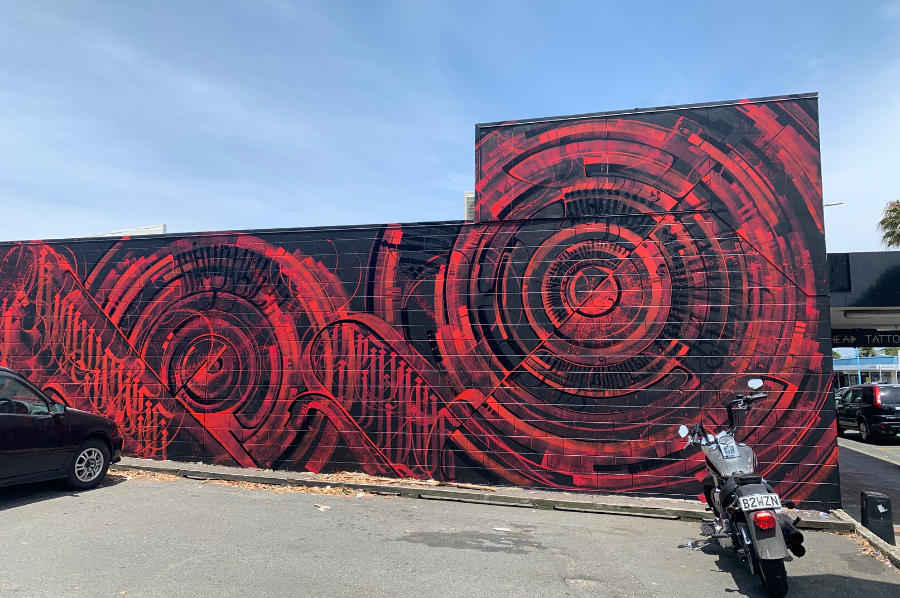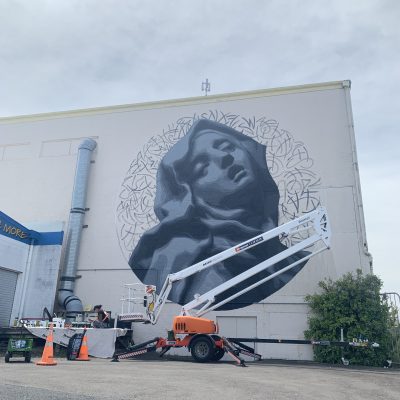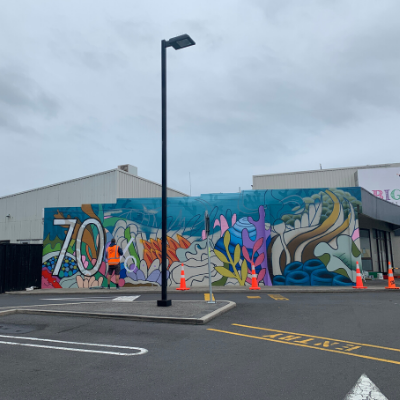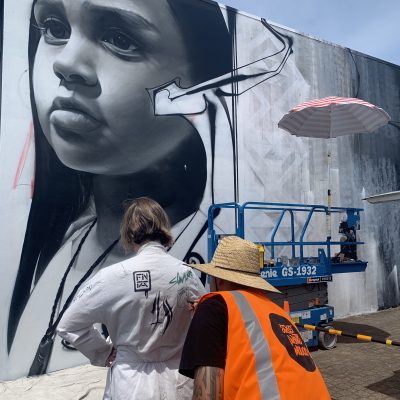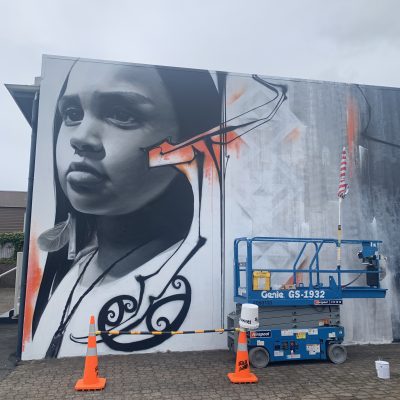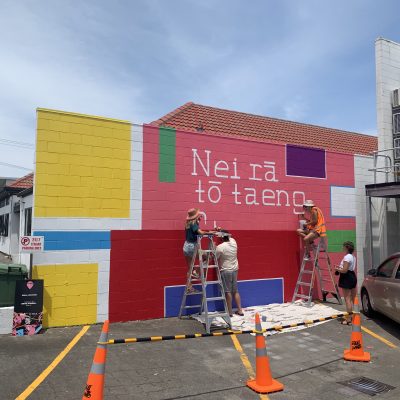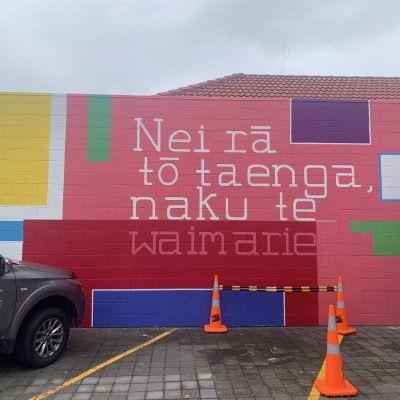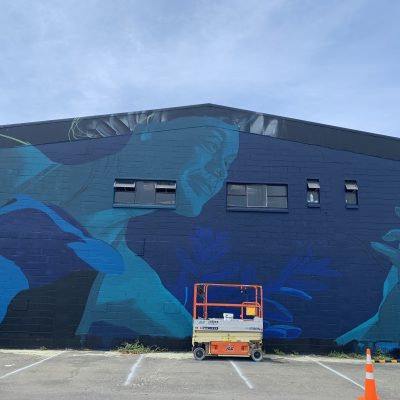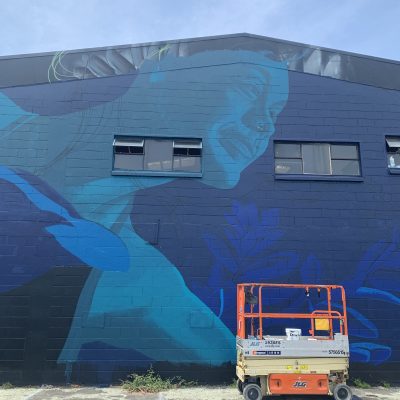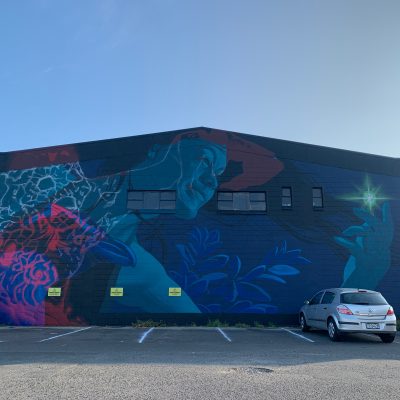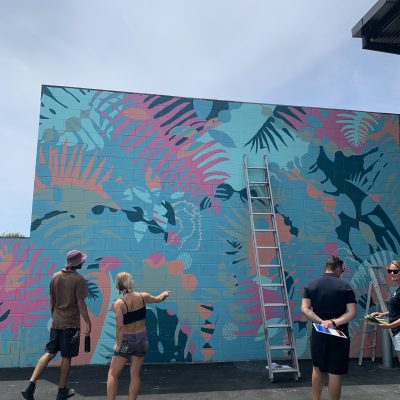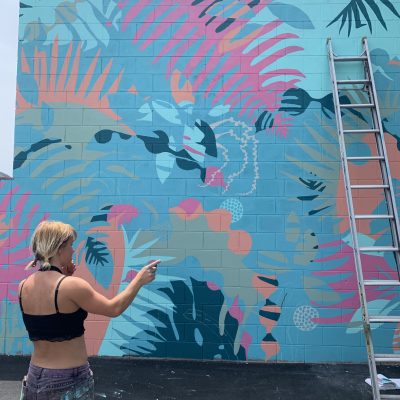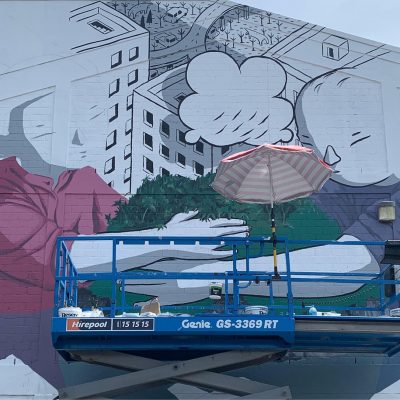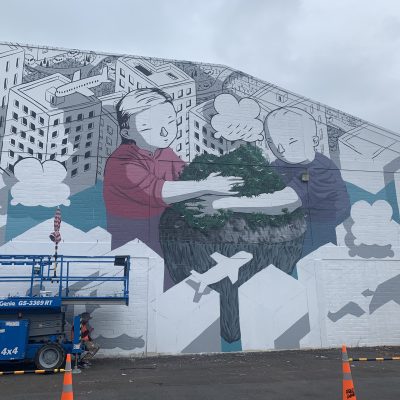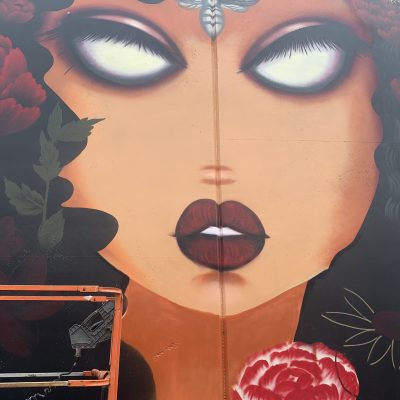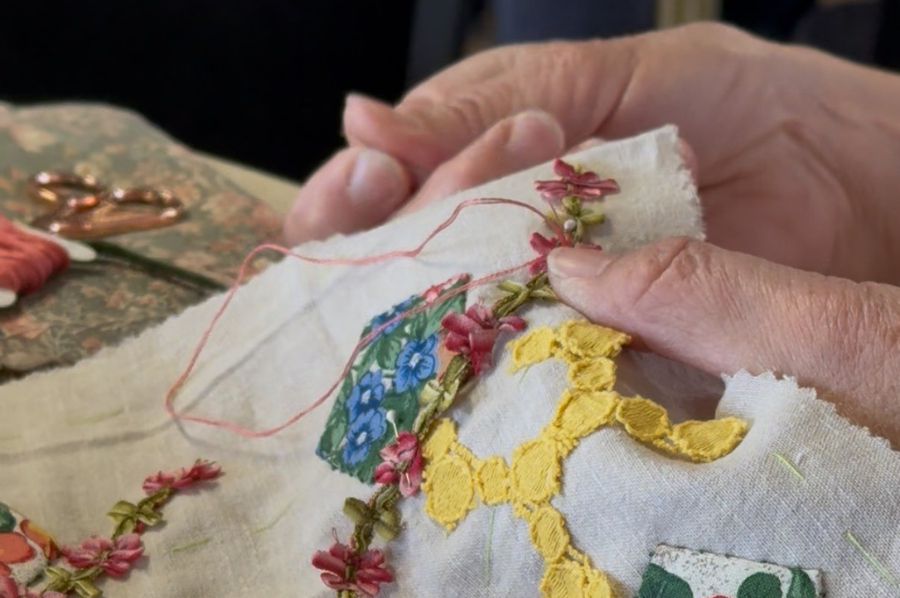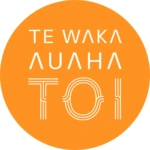We were lucky enough to chat with several of the artists involved in Street Prints Mauao 2020 as they worked on their walls. We asked each creative two questions: could they tell us about their mural, and why do they think having art in public places is important? Here’s what they had to say…
Shane Walker – Facebook | Instagram
1. Tell us about your mural.
The idea is about regenerating the forest. We have the kokako around the corner, which is the water-bearer. The child’s going to be following in its footsteps planting seeds, and in her footsteps is going to be the green pasture left behind.
2. Why do you think it’s important to have art in public places?
Art adds vibrancy to some of these otherwise boring walls, and I think it helps the community have some ownership over their city. It’s something any walk of life can appreciate and take ownership of.
Shane’s mural, corner Wharf & Durham Streets
Eric Skotnes – Instagram
1. Tell us about your mural.
This piece is inspired by a sculpture by Bernini named The Ecstasy of Saint Teresa. The background will be plant life, but it’s been inverted so the plants are white. It’s a very subdued white and light grey colour, to accent her and pop her out.
2. Why do you think it’s important to have art in public places?
I believe art is necessary to inspire youth to take a creative path. It opens up all kind of opportunities. Myself, I was inspired when I was young and saw people doing graffiti, I must’ve been 11, and I thought: that’s what I want to do. I saw a guy doing a huge skull in the middle of the LA river (illegally): that’s what I gravitated towards, so I think doing stuff like this, having kids see it – it might inspire them to do something even more grand, as they grow up. Or to just follow some sort of path, some sort of passion.
Eric’s mural next to Countdown in Te Puke
Alex McLeod – Facebook | Instagram
1. Tell us about your mural.
The theme for this year’s Street Prints festival was: “Although it is small, it is precious.” I contemplated that for a while and wanted to come up with a concept that wasn’t necessarily the first thing that popped into my mind. I’ve been reading about and hearing about seaweed quite a lot lately, and it’s not necessarily small but I think it’s small in our consciousness and awareness. In actual fact, seaweed is pretty awesome. One fact that I’m going to include in this mural is that 70% of the world’s oxygen comes from seaweed. That’s pretty crazy when you think about it. Basically, we breathe thanks to seaweed. It also acts as a carbon sink, so it’s actually soaking up carbon from the atmosphere which also gets into the ocean. It’s been used as a protein, it’s been used as stock feed, because it’s got lots of anti-oxidants. It’s a habitat for fish. The list goes on.
2. Why do you think it’s important to have art in public places?
I think public art beautifies a city. It gives people a connection. It’s either a grey wall, or a whole lot of colour that will hopefully impact people in a positive way.
Alex’s mural next to McDonald’s, Maunganui Rd
Tawck – Facebook | Instagram
1. Tell us about your mural.
I paint a lot of our tamariki, and this is a portrait of Raiha and I’ve also put a few Maori patterns through there to acknowledge the rivers, the maunga or the reflection off the maunga, and also a mangōpare design to represent perseverance as our tamariki will encounter, you know, struggles as they grow up. With support around them, they can achieve anything.
2. Why do you think it’s important to have art in public places?
It ties into why I paint our tamariki. If they are getting into art, it gives them something to choose career-wise. Plus it brightens up dark alleyways.
Tawck’s mural on Orion Lane, Mt Maunganui
Israel Randell – Instagram
1. Tell us about your mural.
The colours are inspired by the little sticks we used to use to learn Maori language back in the day. The phrase “Nei rā tō taenga, nāku te waimarie” means “You’ve arrived and I’m lucky to have you here.” It’s like an arrival; people find it and stumble upon it, and then the wall is welcoming them. And it’s in Maori because I feel like there’s not enough street art that has Maori language in it.
2. Why do you think it’s important to have art in public places?
I think we need it to disrupt the every day [life]. People who work nearby are like “woah!” when they come, so it’s a little reminder to look up I guess.
Israel’s wall on Bounty Lane, Mt Maunganui
Insane51 – Facebook | Instagram
1. Tell us about your mural.
This one is inspired by the movie Moana. I wanted do something related to the island. The face is Jah’s daughter (the organiser). She’s holding a gem which is the gem of life. On the blue layer I’m going to paint everything living, the creatures, like this penguin here. And then I’m going to add a second layer on top which is going to be the skeletons. The gem is giving life; without the gem, there is no life, basically.
2. Why do you think it’s important to have art in public places?
I think having art in public spaces gives everyone the opportunity to see art without having to go to a museum and pay an entrance fee. You just have it here and you can bump into it by accident – that’s what I like about it. You can just go for a walk and be in a parking lot, and boom – you see this wall.
Insane51’s wall on Walls Lane, Mt Maunganui
Faye Suzannah – Instagram
1. Tell us about your mural.
I’m always really into the plants and the flowers in new places that I go, because they’re usually pretty bold, especially in hot countries. My partner is a plant man, can’t avoid it, and my little girl is picking up all these crazy pods: banksia pods, magnolia tree pods, so the first thing I collected in my house was all these little pods. I’d made some sketches of these weird pine cones and pods, so when this opportunity came out of the blue, and the brief was about precious little things, I just thought it was good that it matched that, and that I was able to apply the pretty standard approach that I have with murals, which involves big plant shapes and big colours.
2. Why do you think it’s important to have art in public places?
Maybe it shakes people out of their normal thing, even if it’s just for a couple of seconds. Everyone can be really involved with their daily task and not really that present, and if they’re like “Woah! Okay! Never thought of that plant before.” Even if they just have a little daydream for a few minutes, maybe that’s it – a bit of a distraction. I get the word cheerful quite a lot [about my mural] and obviously that’s important, for everyone to be happy. This colour blue and this colour pink are pretty much my happy colours, so I thought, if I’m going to paint this enormous wall by myself, I have to have turquoise in my eyes.
Faye’s mural on Phoenix Lane, Mt Maunganui
Millo – Facebook | Instagram
1. Tell us about your mural.
The two characters represent the future generations taking care of the land, in this case the land is represented as an island that can be New Zealand but can also be our planet. It’s a kind of protection of what’s most important for us from the development. It always stands to attack what is important.
Millo’s mural on Bounty Ln, Mt Maunganui
Amanda Valdes – Instagram
1. Tell us about your mural.
The inspiration is the theme of the mural festival: although small, it is precious. A lot of nature inspired themes; bugs, florals, stuff like that.
2. Why do you think it’s important to have art in public places?
I think it’s important so it’s easily accessible for everybody; so people aren’t intimidated to walk inside of a gallery or a museum. Everybody can see it without having to do all of that.
Amanda’s mural on Nikau Crescent, Mt Maunganui

